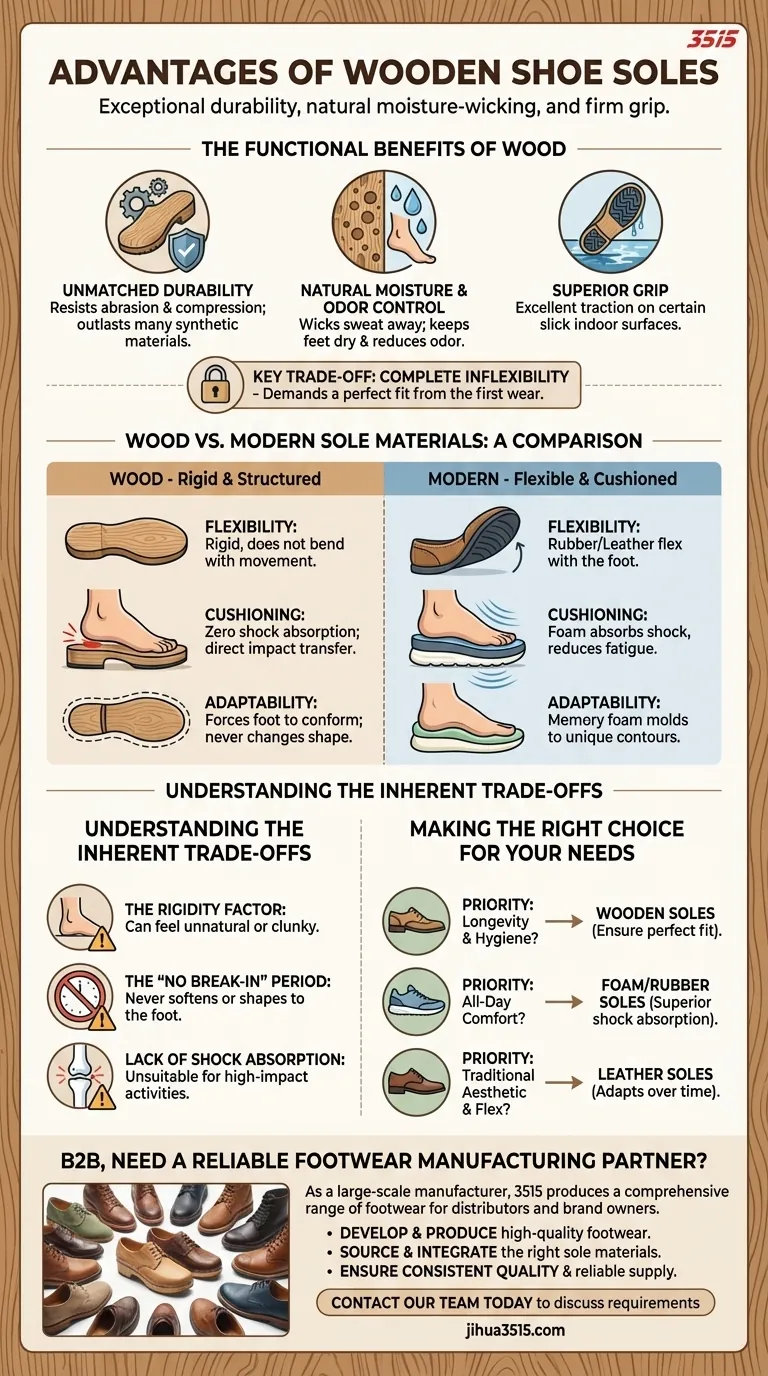The primary advantages of wooden shoe soles are their exceptional durability and natural moisture-wicking properties. They effectively absorb sweat, keeping feet dry and reducing odor, while also providing a firm, reliable grip on smooth surfaces.
While modern materials prioritize flexibility and cushioning, wooden soles offer a unique combination of extreme durability and a naturally dry, healthy foot environment. The critical trade-off is their complete inflexibility, which demands a perfect fit from the very first wear.

The Functional Benefits of Wood
Wooden soles are not a relic of the past; they serve specific functional purposes that synthetic materials often cannot replicate. Understanding these core strengths is key to appreciating their role.
Unmatched Durability
Wood is an incredibly hard-wearing material. A well-crafted wooden sole can outlast many of its rubber or foam counterparts, resisting abrasion and compression over time.
Natural Moisture and Odor Control
Wood is naturally porous and absorbent. This allows it to wick moisture and sweat away from the foot, creating a drier environment that is less prone to bacterial growth and associated odors.
Superior Grip on Specific Surfaces
The hard, defined edge of a wooden sole can provide excellent traction on certain slick or wet indoor surfaces where softer materials might slip.
Wood vs. Modern Sole Materials
To truly understand wood's place, it's essential to compare it directly to the most common alternatives. Each material is engineered for a different outcome.
Flexibility: Wood vs. Rubber and Leather
Wooden soles are rigid. They do not bend or flex with the natural movement of your foot.
In contrast, rubber soles are designed for flexibility, making them ideal for sneakers and athletic footwear. Leather soles start out pliant and gradually mold to your walking pattern, offering a blend of structure and personalized flex.
Cushioning: Wood vs. Foam
Wood offers zero shock absorption. The impact of each step is transferred directly through the sole to your foot and joints.
Foam soles are the complete opposite. They are engineered specifically to absorb shock, providing cushioning that reduces fatigue and stress on the body during activities like walking or running.
Adaptability: How Soles Conform
A wooden sole forces the foot to conform to its rigid, pre-defined shape.
Materials like memory foam do the reverse; they adapt and mold to the unique contours of your foot, providing tailored arch support and comfort.
Understanding the Inherent Trade-offs
Choosing a wooden sole means accepting a clear set of compromises. Ignoring these can lead to significant discomfort.
The Rigidity Factor
The primary drawback is wood's complete inflexibility. This can make walking feel unnatural or clunky for those accustomed to modern, flexible footwear.
The "No Break-In" Period
Unlike leather, which softens and shapes to your foot over time, a wooden sole will never change its shape. If the shoe doesn't fit perfectly from the moment you put it on, it never will.
Lack of Shock Absorption
The absence of cushioning makes wooden soles unsuitable for high-impact activities or long periods of standing on hard surfaces, as it can lead to foot and joint fatigue.
Making the Right Choice for Your Needs
Selecting the right sole material depends entirely on your priority. There is no single "best" option, only the right tool for the job.
- If your primary focus is longevity and foot hygiene: Wooden soles are an excellent choice, provided you can ensure a perfect, comfortable fit from day one.
- If your primary focus is all-day comfort and cushioning: You should opt for foam or rubber soles that provide superior shock absorption and flexibility for walking or standing.
- If your primary focus is a traditional aesthetic with flexibility: Leather soles offer a classic look for dress shoes while gradually adapting to your foot over time.
Ultimately, choosing a wooden sole is a commitment to a specific type of performance—one that values structure and durability above all else.
Summary Table:
| Advantage | Description |
|---|---|
| Unmatched Durability | Incredibly hard-wearing, resists abrasion and compression over time. |
| Natural Moisture Control | Porous wood wicks sweat away, keeping feet dry and reducing odor. |
| Superior Grip | Provides excellent traction on certain slick or wet indoor surfaces. |
| Key Trade-off | Complete Inflexibility - Requires a perfect fit from the first wear. |
Need a Reliable Footwear Manufacturing Partner?
As a large-scale manufacturer, 3515 produces a comprehensive range of footwear for distributors, brand owners, and bulk clients. Our production capabilities encompass all types of shoes and boots, including styles that utilize the unique benefits of wooden soles for durability and hygiene.
We can help you:
- Develop and produce high-quality footwear tailored to your market's needs.
- Source and integrate the right sole materials for your design and performance goals.
- Ensure consistent quality and reliable supply for your business.
Contact our team today to discuss your footwear production requirements and how we can add value to your brand.
Visual Guide

Related Products
- Safety Footwear Wholesale Manufacturer for Custom OEM/ODM Production
- Custom OEM Training Shoes Wholesale Manufacturer Durable & Breathable
- Durable Moc-Toe Wedge Work Boots | Wholesale Manufacturing for Brands
- Durable Rubber Sole Outdoor Shoes Wholesale & Custom Manufacturing
- Durable Waterproof Rain Boots | Custom Manufacturer for Wholesale & Brands
People Also Ask
- What are OSHA approved shoes? Understanding the Correct Standards for Workplace Safety
- Is safety-toe as good as steel toe? Choose the Right Protection for Your Job
- What do heavy duty boots do? Protect Your Feet in Demanding Work Environments
- Do snake bite boots work? Your Ultimate Guide to Effective Snake Bite Protection
- What cultural and environmental considerations are tied to wearing shoes indoors? Balance Hygiene, Tradition, and Foot Health



















